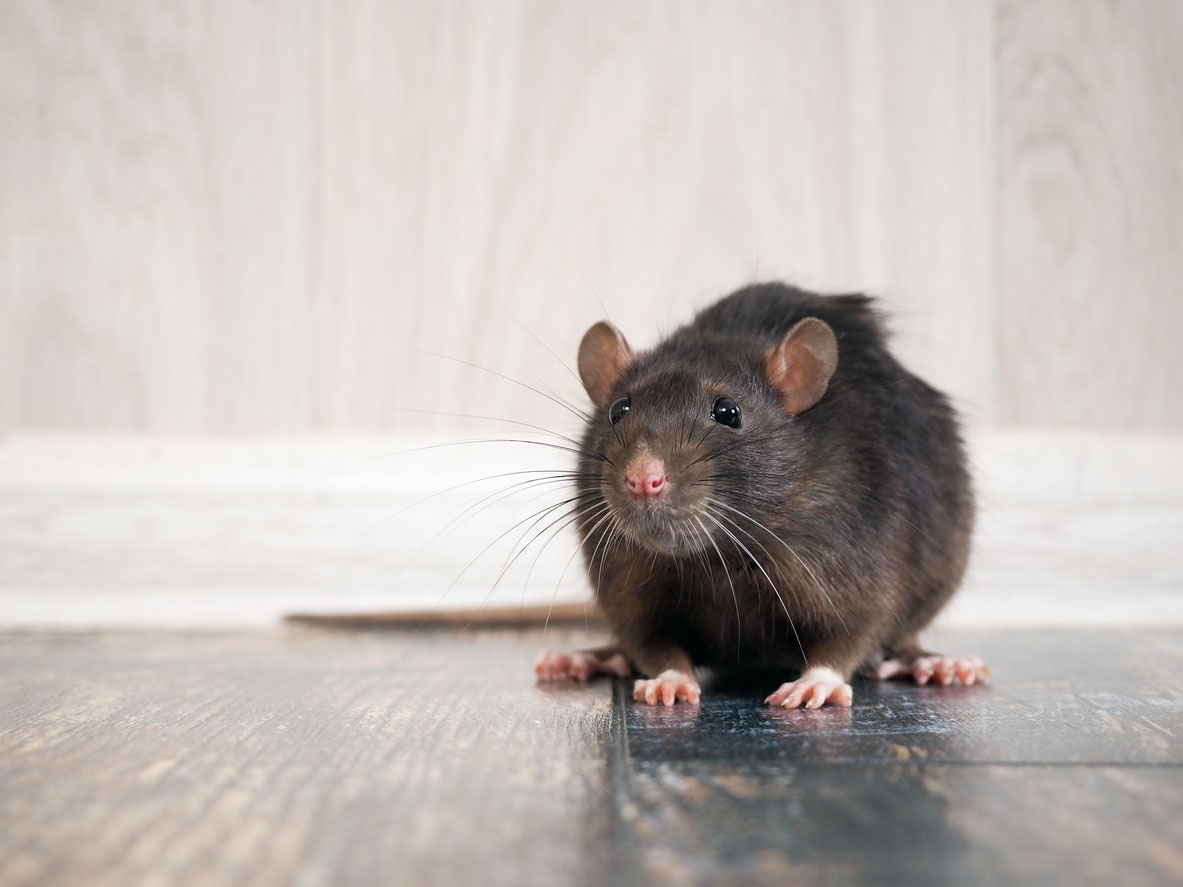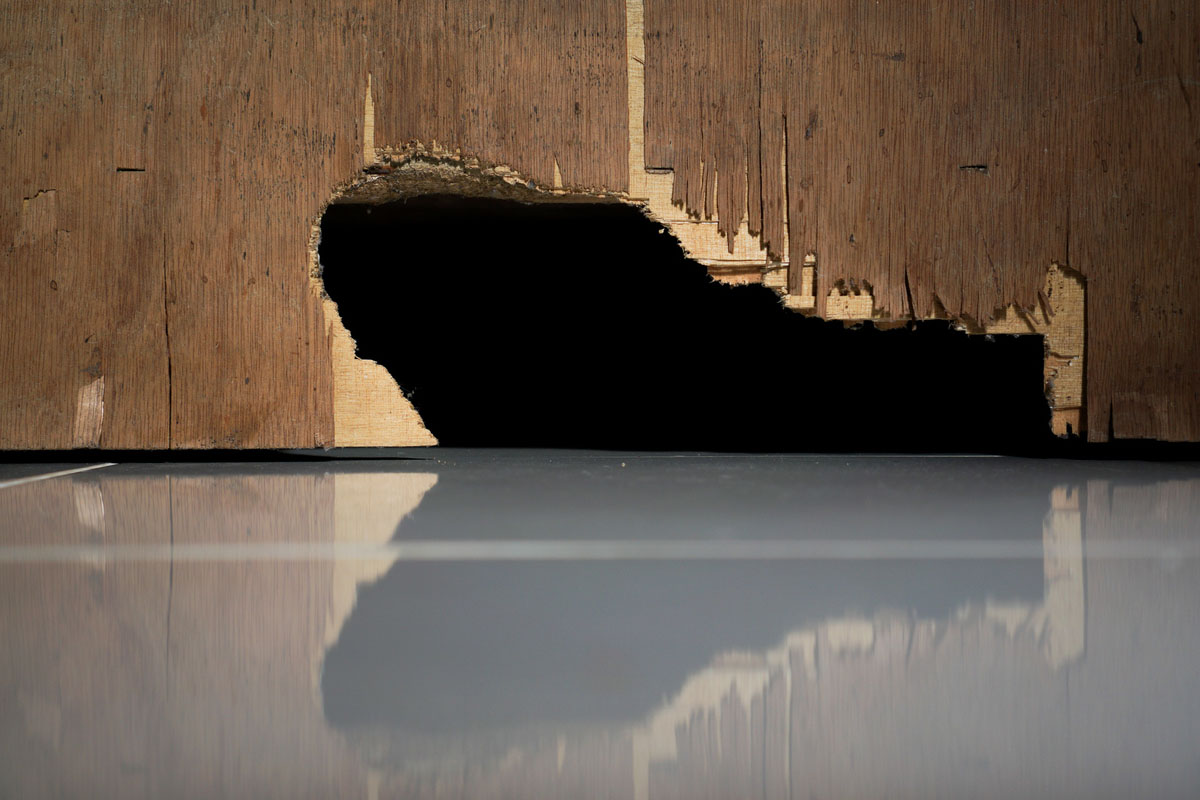

We may earn revenue from the products available on this page and participate in affiliate programs. Learn More ›
Oh, rats, the dreaded rodent infestation. These pesky creatures are tenacious when they’ve found a new place to nest. Worst of all, they carry deadly diseases and bacteria that pose a risk to a home’s rightful inhabitants. Rats can take up residence in your house, yard, or shed and cause significant damage in no time. They chew through insulation, wiring, wood, drywall—just about anything. And they eat almost anything, too. The destruction they cause can cost homeowners in the long run, whether for minor repairs or accidental fires from exposed wiring. Additionally, rats frequently breed throughout the year and can birth up to 2,000 babies in one year. If any babies are born on your property, they’ll quickly be trained to infiltrate every area of your home in their search for food and shelter. Knowing how to get rid of rats quickly is a must for homeowners who suspect they have a rat infestation.
There are a few ways to identify a rat infestation. You may see large rat droppings on the floor or around your house, or you could see evidence of gnawed wood, wires, or furniture. Rats also make a scurrying, squeaking sound when they run through the walls or in the ceiling—usually more audible than mice since they’re larger. They also have a musky scent that’s similar to ammonia. Rats can range in size from a mere 5 inches to the size of a house cat, although that’s rare to see. You’ll typically find them located near coastal areas in warmer climates.
Rat infestations are no joke, so be sure to call an exterminator from one of the best pest control companies (such as Orkin and Terminix) if you’re wondering the best way to get rid of rats. Since they carry dangerous diseases and pose a risk to a house’s safety, it’s crucial to get rid of rats quickly. They’re surprisingly crafty, so it can take a few attempts to nab the little critters using several deterrents. Here is some helpful information to determine if you have a rat problem and learn how to prevent rats from getting into your house.
Time required: Several days
Difficulty: Intermediate
Estimated cost: $40 to $343
Tools & Materials
Bobvila.com may earn a commission from purchases made through these links.
- Ladder (if needed)
- Window screen repair kit (if needed)
- Rat snap trap
- Snap traps
- Bait traps
- Ultrasonic pest repeller
- Caulk or expanding spray foam
- Weatherstripping (if needed)
- Wire mesh (if needed)
- Siding, plywood, or cement board (if needed)
- Paving stones or bricks (optional)
- Peppermint-based or natural repellents
Before You Begin…

Exercise caution when searching for signs of a rat infestation. Approximately 50,000 Americans are bitten by rats each year, posing a severe health risk since rats carry many infectious diseases. If you choose to set up snap traps, handle them carefully when setting the bait to avoid being caught in the trap yourself. Any poisoned rodent bait must be handled with care and kept away from pets and children to avoid accidental poisoning. Also, if you choose to inspect your house and make repairs to prevent rats from getting in, use appropriate safety gear when using tools. The best alternative is to allow a licensed rat exterminator or rat control service to handle the inspection and baiting process to get rid of rats.
Tips for How to Get Rid of Rats
- Inspect entryways or gnawed openings carefully.
- Seal up any openings (foundation, window screens, roofs, walls, etc.) that are at least ½ inch, as rats can easily squeeze through small holes.
- Choose a rat-size snap trap to make sure it can trap rodents larger than mice.
- Keep your home repaired and maintained to prevent leaving areas where rats and other pests can easily access the house.
- Store food of any kind, whether birdseed, dog food, food in your pantry, in tightly sealed containers.
- Keep trash bins tightly closed and tidy.
- Trim tree branches so they don’t hang over your house and provide easy access to your roof.
Safety Considerations
- Rodent bait is poisonous, so be sure to follow all state and federal laws for handling and using it safely.
- Only use the style of rat removal trap that you’re comfortable with having in your house.
- Use caution when opening and setting a rat snap trap.
- If using a ladder, make sure it is securely planted before using it to repair any window screens or caulk openings.
STEP 1: Inspect the home and its surroundings, including your backyard and garden.
Rats look for the most accessible point of entry, starting with your yard. Gaps in the fence along the ground, tree branches that hang over your house, and heavy vegetation or piles of junk around the house are some common ways that rats will invade your space. You’ll want to check your house for visible signs of entry or nesting to begin the process of rat removal.
Look for signs of rats by checking for small, dark droppings near any possible entry points, debris, or dense vegetation. There may also be signs of gnawed drywall where the rat tried to make a larger opening in a wall. Rats tend to walk right next to walls due to their poor eyesight, so you may even notice a slightly greasy streak where they’ve brushed against the wall. Open trash bins attract rats as well. Check to ensure that all exposed pipes have the proper mesh installed to prevent rats from gaining access and that any holes in window screens or around any cables or vents leading to the interior are fully sealed. Inside your house, you’ll need to investigate for rat droppings, evidence of gnawing, and sounds of scurrying within your walls.

STEP 2: Seal any cracks in the walls or foundation and block access to the home.
Mice only need a ¼-inch hole to get into a house, but rats need a ½-inch hole. However, their long teeth are extremely adept at opening up those ¼-inch holes to fit their flexible bodies through the space. Admittedly, that’s a tiny hole to be searching for in the house, so finding the gaps where the rats are getting into the house or shed can be challenging. That’s where it’s helpful to hire a rat exterminator to solve the problem. An exterminator can quickly inspect the exterior and find the problem areas.
If there’s a hole or gap in the wall or near the roof, expanding spray foam or caulk is an excellent way to block it off. Use wire mesh to seal off any pipes or vents. Recaulk any leaking roof vents that rats could access, too. Install new weatherstripping on the base of any outside doors, and repair any window screens with holes. Any large gaps should be sealed with new siding, plywood, or cement board as appropriate. You could even install a row of paving stones or bricks along your foundation to deter rats from tunneling underneath.
STEP 3: Maintain your home’s surroundings.
Rats are just like any other pest: They prefer to hide in debris-filled areas that provide easy access to food, shelter, or water. That’s why it’s vital to keep unsightly piles of junk or yard debris from piling up near any structures like your house, shed, fence, or deck. It’s basically an open invitation for a critter to set up a nest and infiltrate your house. Significant vegetation near the house (or growing on the house) also poses a hazard since rats can remain hidden as they work to find a weakness they can exploit. Any areas where water pools will also attract rats, even though they don’t need a lot of water to survive.
Make an effort to keep your yard and house clean and tidy so rats have less of a chance or inclination to get into your home and stay. Keep leaves cleaned up in the fall, remove old junk piles, and keep your trees trimmed away from your roof so they don’t make an easy highway for the rats to get to your roof.
STEP 4: Remove potential food sources.
One of the best ways to get rid of rats is to eliminate their access to potential food sources. Rats may not eat as much as you’d expect, but they still prefer to have easy, regular access to food and water. The type of food rats will eat is almost limitless: garbage, dog food, human food, or birdseed—rats aren’t picky eaters.
If you store any pet food outside, be sure to keep it in a tightly sealed container to prevent pests and rodents from getting into it. Even if the opening is rolled down, an open bag emits an alluring aroma that rodents can smell from an impressive distance. This holds true for food inside your house as well. Once a rat has made its way in, it’ll take up residence not too far from a food source, which is probably your pantry. Be sure to keep food in airtight containers or buckets so rats can’t smell or get into it. Avoid keeping food in any bedrooms or even on the patio for any reason. Any food storage you have could be at risk, so if you have bags of flour, rice, or beans, be sure to check them to make sure rats have not gotten into them. Transferring them to storage buckets is the safest bet to prevent attracting rats.
They’re also attracted to any fruit that is ripening on fruit trees in your yard, and they’ll happily harvest fallen seeds and nuts from other plants and trees you may have. You’ll want to stay on top of cleaning up any fallen fruit, nuts, or seeds to prevent attracting rats.

STEP 5: Contact a professional pest control company.
There are plenty of rat-trapping gadgets available that may or may not work. Some common items are snap traps, bait traps, peppermint-based repellents, and ultrasonic repellers. However, it’s one thing to simply set out a bait trap, and it’s another to know where to place it and what to fill it with for maximum success. Your best bet is to call a professional pest control company for rat removal—especially if you’re wondering how to get rid of rats in the walls. Once they’re inside your house, it’s pretty tricky to get them out. A common mistake homeowners make when trying to get rid of rats on their own is to put out poisoned rodent bait in an area where the rats can then escape into a hard-to-reach area. The rat then dies and slowly decays, emitting a truly foul odor into your house.
A qualified rat exterminator will know exactly how and where to place the bait traps and snap traps to prevent that from happening. You can consult with them about the best kind of rat trap to use for your needs. They’re also experienced at inspecting every nook and cranny of your house to identify the most vulnerable entry points. Most importantly, pest control companies are familiar with local laws regarding the placement and use of different kinds of bait traps in your area. While it’s critical to get rid of rats as soon as possible, you also need to do so safely so your kids and pets don’t accidentally ingest the bait and so the rats don’t die inside the walls of your house.
If you’re wondering how to get rid of rats, you’re not alone. Many homeowners experience a rat infestation on their property that requires the assistance of a professional pest control company. It’s imperative to exercise caution when investigating whether you have a mouse or rat problem. Rats are filthy creatures that carry infectious diseases and bacteria that can easily transmit to humans. These wild rodents aren’t like the occasional pets some people choose to keep, so it’s essential to keep them out of the house and yard. Keeping a tidy home and property is the first line of defense to getting rid of rats, as is keeping any food sources limited by putting pet and human food in sealed bins. Once you’ve eliminated the rat infestation with the help of a pro, these preventative steps will help you stay ahead of any future rat problems.
